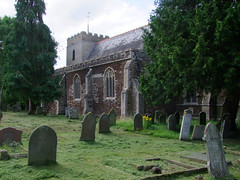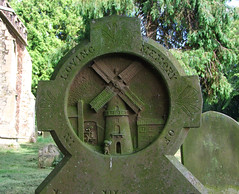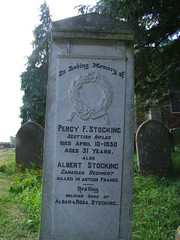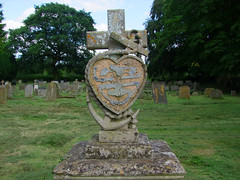| |
|
All
Saints, Hilgay
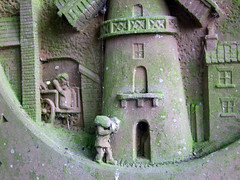 |
|
Hilgay
is one of those large, independent south-west
Norfolk fen villages that feel as if they really
ought to be in Cambridgeshire. The church is set
away from the village centre, and you'd be
unlikely to find it without a map if it wasn't
for the handily named Church Street. All Saints
is set about a hundred metres back from the road,
and the avenue of limes that lead up to it are
undoubtedly the longest in East Anglia. A local
once told me it was the longest lime avenue in
the world, which may also be true, although I
don't suppose there are hundreds of lime avenues
in Africa, Latin America and South-East Asia
queuing up to compete with it.
The church appears long and apparently low,
although this is in fact an illusion caused by
the squatness of the tower. It appears very
un-East Anglian, the nave and chancel in layered
carstone and the tower in white brick. The
carstone of the south aisle is not layered but
ragged, and this creates a very primitive, rugged
effect, like a marbled gingerbread cake. The
ramshackle appearance of the tower contributes a
bit as well. |
The large
gravestone with an anchor, cross and heart on this side
of the graveyard is striking, and you might think at
first it is the memorial to Hilgay's most famous son,
Captain Thomas Manby. Manby was the inventor of the Manby
cradle, a device for rescuing sailors from stranded ships
at sea (I hope you're taking notes, there will be a test
at the end) but in fact it isn't. His memorial is inside
the church. When I came here in 2005, this large
memorial, which actually depicts the Christian virtues of
Faith, Hope and Charity, still had a heart-shaped
lead-plate with the name and details of the grave's
inhabitant, but it won't surprise you to learn that this
has long since been stripped away. The best memorial on
this side of the church is to John Whittowe, who died in
1891. It features a deeply cut relief of a windmill, the
workers busy unloading sacks of grain from the back of a
cart.
George Street undertook the considerable restoration of
All Saints in the 1860s, although the tower predates this
by about seventy years, replacing one which collapsed in
the 1790s. The interior is wide and open, and at first
appears almost entirely 19th century. The aisle is as
wide as the nave, and the aisle chapel altar is as grand
and dressed as the main altar. It feels a little like two
churches side by side. Just inside the door is a very
rare beast, a glass-walled funeral bier. The font is a
grand Victorian marble job, and matches the not quite so
successful pulpit. They do seem a little out of place
here, a reminder that Street's urban, sophisiticated
style is sometimes a little uncomfortable in East Anglia.
A fashion
which never really caught on, more's the pity, was the
practice of placing encaustic memorial tiles on the wall.
This seems to have arisen in the 1880s, and had more or
less disppeared by the 1920s. There are some at Hilgay,
which are particularly interesting because they include
three to boys killed in the trenches of the First World
War. One of them is in Latin: Ludovicus Eduardus
Iosephus Maude, it reads, inter gallos pro
occubuit kal: Iul:MCMXCI ann: nat: XXV Requiem aeternam
dona ei Domine. This translates as 'Louis Edward
Joseph Maude, who died in the war for freedom, first day
of July 1916 aged 25. Grant him eternal rest Lord.' Which
is to say, of course, that young Louis Maude died on the
first day of the Battle of the Somme.
 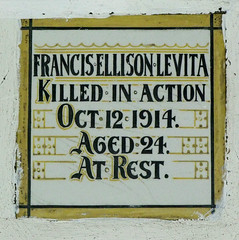 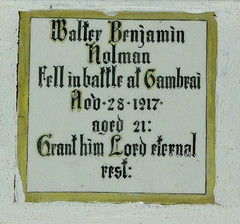
There is a
good set of 15th century benches with animals on some of
the ends, including a rather disturbing anthropomorphic
creature that I suppose must be something from a
bestiary. From a century or so later comes the memorial
to Henry and Ursula Hawe in the south aisle chapel.
All Saints is at first sight not the most exciting of
churches, but it is full of little details and has a
lovely harmonious feel, from the stations of the cross to
the good late 19th century glass by Ward and Hughes, from
the screen brought from the redundant St Mary Beswick in
Manchester to the jaunty little gallery shoehorned under
the tower which Pevsner, unaccountably, thought dull.
Captain
Danby's memorial is in the south aisle chapel,
and records that his is a name to be remembered
as long as there is a stranded ship. Poignantly,
the memorial also remembers four of his eight
brothers and sisters who died in infancy. It is a
fairly typical sentimental memorial of the
mid-19th century, but has a striking addition
that you only notice after a moment. In another
hand along the bottom, someone has inscribed
carefully The public should have paid this
tribute. How curious! There must be a story
there somewhere.
This church has a long-standing Anglo-catholic
tradition, and as part of that it used to be open
every day. I am afraid that this is no longer the
case, and there is not even a keyholder notice
now. |
|
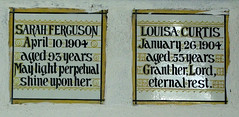 |
|
|
|


